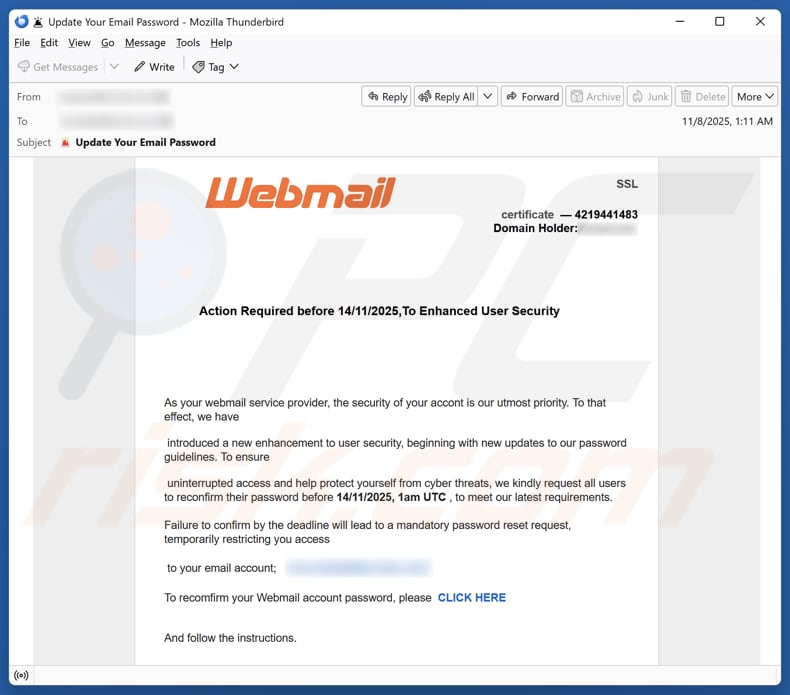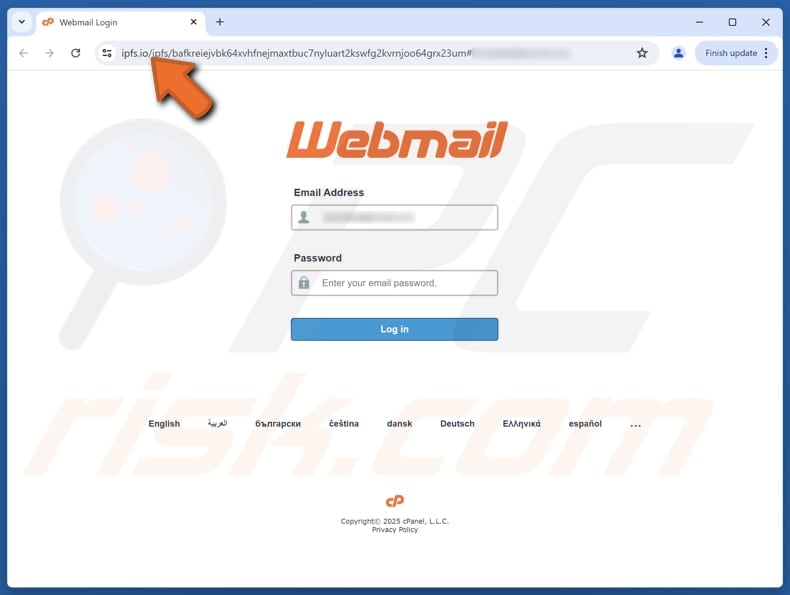How to spot scams like "Webmail - Action Required To Enhance Security"
Phishing/ScamAlso Known As: Webmail - Action Required To Enhance Security phishing email
Get free scan and check if your device is infected.
Remove it nowTo use full-featured product, you have to purchase a license for Combo Cleaner. Seven days free trial available. Combo Cleaner is owned and operated by RCS LT, the parent company of PCRisk.com.
What kind of scam is "Webmail - Action Required To Enhance Security"?
We have reviewed the email and concluded that it is a phishing attempt. The message is disguised as an urgent notification from the email service provider. It encourages the recipient to open a fake website. The purpose of this scam is to extract personal information from recipients through a fake web page.

More about the "Webmail - Action Required To Enhance Security" scam email
This email poses as the Webmail service provider and claims that it prioritizes user security. It warns the recipient that action is required before a specified date to comply with updated password guidelines. The message warns that failure to reconfirm the password by the deadline will result in a temporary restriction and a mandatory password reset.
It includes a link ("CLICK HERE" button) to "reconfirm" a password and instructs the recipient not to reply. Clicking the provided link opens a deceptive website designed to steal login credentials. This site imitates the recipient's email service provider. For example, if the recipient uses Yahoo Mail, the page appears as the Yahoo Mail login site.
On the fraudulent page, visitors are instructed to enter their login credentials (email addresses and passwords) for email accounts. With stolen login details, criminals can access email accounts and misuse them to send phishing messages, spread malware, send spam, gather private data, and more.
They may also sell these compromised accounts to other criminals. In addition, fraudsters might try to access social media, online banking, gaming, and other services using the same credentials. For this reason, it is crucial to ignore suspicious messages, avoid clicking unknown links or opening unexpected attachments, and never enter personal details on shady sites.
| Name | Webmail - Action Required To Enhance Security Email Scam |
| Threat Type | Phishing, Scam, Social Engineering, Fraud |
| Fake Claim | Failure to reset the password will lead to restricted acces to the email account |
| Disguise | Message from the email service provider |
| Symptoms | Unauthorized online purchases, changed online account passwords, identity theft, illegal access of the computer. |
| Distribution methods | Deceptive emails, rogue online pop-up ads, search engine poisoning techniques, misspelled domains. |
| Damage | Loss of sensitive private information, monetary loss, identity theft. |
| Malware Removal (Windows) |
To eliminate possible malware infections, scan your computer with legitimate antivirus software. Our security researchers recommend using Combo Cleaner. Download Combo CleanerTo use full-featured product, you have to purchase a license for Combo Cleaner. 7 days free trial available. Combo Cleaner is owned and operated by RCS LT, the parent company of PCRisk.com. |
Conclusion
This scam email tries to trick recipients into entering their login credentials on a fake webpage by pretending to be a security notice from their email provider. Its goal is to steal account details for further misuse and fraud. Users should ignore such messages and avoid clicking links or providing information on unfamiliar sites.
It is important to note that scam emails can be used to deliver malware. Here are some examples of similar scams: "SOA & Invoices", "Interactive Brokers - Renewal of W-8BEN Form Required", and "Changes In The cPanel Webmail Server".
How do spam campaigns infect computers?
Threat actors often spread malware through email by hiding it inside infected Office documents, PDFs, ZIP/RAR archives, scripts, executable files (.exe), and other attachments. The malicious software usually stays inactive until the user opens the file or follows the instructions inside it.
Attackers may also add links to harmful or fake websites in the email. Visiting these sites can result in malware being downloaded automatically or the user being tricked into downloading and running it themselves.
How to avoid installation of malware?
Do not open files or click links in irrelevant or unexpected (or suspicious) emails or other messages from unknown senders. Download apps and files only from trusted sources, such as official websites or reputable app stores. Do not use pirated software, cracks, and keygens. Keep your system and apps up to date.
Avoid clicking ads, pop-ups, or suspicious links on risky sites, and never allow these pages to send notifications. Use reliable security software and scan your device regularly.
Text presented in the "Webmail - Action Required To Enhance Security" email letter:
Wemail
SSL certificate — 4219441483
Domain Holder:********Action Required before 14/11/2025,To Enhanced User Security
As your webmail service provider, the security of your accont is our utmost priority. To that effect, we have introduced a new enhancement to user security, beginning with new updates to our password guidelines. To ensure uninterrupted access and help protect yourself from cyber threats, we kindly request all users to reconfirm their password before 14/11/2025, 1am UTC , to meet our latest requirements.
Failure to confirm by the deadline will lead to a mandatory password reset request, temporarily restricting you access to your email account; ********
To recomfirm your Webmail account password, please CLICK HERE
And follow the instructions.
Kind regards,
WEBMAIL TEAMPlease don't reply to this email.
Copyright © 1996–2025
Webmail.com All rights reserved.
Fake website used in this scam:

Instant automatic malware removal:
Manual threat removal might be a lengthy and complicated process that requires advanced IT skills. Combo Cleaner is a professional automatic malware removal tool that is recommended to get rid of malware. Download it by clicking the button below:
DOWNLOAD Combo CleanerBy downloading any software listed on this website you agree to our Privacy Policy and Terms of Use. To use full-featured product, you have to purchase a license for Combo Cleaner. 7 days free trial available. Combo Cleaner is owned and operated by RCS LT, the parent company of PCRisk.com.
Quick menu:
- What is Webmail - Action Required To Enhance Security phishing email?
- Types of malicious emails.
- How to spot a malicious email?
- What to do if you fell for an email scam?
Types of malicious emails:
![]() Phishing Emails
Phishing Emails
Most commonly, cybercriminals use deceptive emails to trick Internet users into giving away their sensitive private information, for example, login information for various online services, email accounts, or online banking information.
Such attacks are called phishing. In a phishing attack, cybercriminals usually send an email message with some popular service logo (for example, Microsoft, DHL, Amazon, Netflix), create urgency (wrong shipping address, expired password, etc.), and place a link which they hope their potential victims will click on.
After clicking the link presented in such email message, victims are redirected to a fake website that looks identical or extremely similar to the original one. Victims are then asked to enter their password, credit card details, or some other information that gets stolen by cybercriminals.
![]() Emails with Malicious Attachments
Emails with Malicious Attachments
Another popular attack vector is email spam with malicious attachments that infect users' computers with malware. Malicious attachments usually carry trojans that are capable of stealing passwords, banking information, and other sensitive information.
In such attacks, cybercriminals' main goal is to trick their potential victims into opening an infected email attachment. To achieve this goal, email messages usually talk about recently received invoices, faxes, or voice messages.
If a potential victim falls for the lure and opens the attachment, their computers get infected, and cybercriminals can collect a lot of sensitive information.
While it's a more complicated method to steal personal information (spam filters and antivirus programs usually detect such attempts), if successful, cybercriminals can get a much wider array of data and can collect information for a long period of time.
![]() Sextortion Emails
Sextortion Emails
This is a type of phishing. In this case, users receive an email claiming that a cybercriminal could access the webcam of the potential victim and has a video recording of one's masturbation.
To get rid of the video, victims are asked to pay a ransom (usually using Bitcoin or another cryptocurrency). Nevertheless, all of these claims are false - users who receive such emails should ignore and delete them.
How to spot a malicious email?
While cyber criminals try to make their lure emails look trustworthy, here are some things that you should look for when trying to spot a phishing email:
- Check the sender's ("from") email address: Hover your mouse over the "from" address and check if it's legitimate. For example, if you received an email from Microsoft, be sure to check if the email address is @microsoft.com and not something suspicious like @m1crosoft.com, @microsfot.com, @account-security-noreply.com, etc.
- Check for generic greetings: If the greeting in the email is "Dear user", "Dear @youremail.com", "Dear valued customer", this should raise suspiciousness. Most commonly, companies call you by your name. Lack of this information could signal a phishing attempt.
- Check the links in the email: Hover your mouse over the link presented in the email, if the link that appears seems suspicious, don't click it. For example, if you received an email from Microsoft and the link in the email shows that it will go to firebasestorage.googleapis.com/v0... you shouldn't trust it. It's best not to click any links in the emails but to visit the company website that sent you the email in the first place.
- Don't blindly trust email attachments: Most commonly, legitimate companies will ask you to log in to their website and to view any documents there; if you received an email with an attachment, it's a good idea to scan it with an antivirus application. Infected email attachments are a common attack vector used by cybercriminals.
To minimise the risk of opening phishing and malicious emails we recommend using Combo Cleaner Antivirus for Windows.
Example of a spam email:

What to do if you fell for an email scam?
- If you clicked on a link in a phishing email and entered your password - be sure to change your password as soon as possible. Usually, cybercriminals collect stolen credentials and then sell them to other groups that use them for malicious purposes. If you change your password in a timely manner, there's a chance that criminals won't have enough time to do any damage.
- If you entered your credit card information - contact your bank as soon as possible and explain the situation. There's a good chance that you will need to cancel your compromised credit card and get a new one.
- If you see any signs of identity theft - you should immediately contact the Federal Trade Commission. This institution will collect information about your situation and create a personal recovery plan.
- If you opened a malicious attachment - your computer is probably infected, you should scan it with a reputable antivirus application. For this purpose, we recommend using Combo Cleaner Antivirus for Windows.
- Help other Internet users - report phishing emails to Anti-Phishing Working Group, FBI’s Internet Crime Complaint Center, National Fraud Information Center and U.S. Department of Justice.
Frequently Asked Questions (FAQ)
Why did I receive a scam email?
The message was probably sent after scammers collected your email from leaked databases, phishing pages, or similar sources. These scams are not targeted, meaning that scammers send them to a large number of people.
I have provided my personal information when tricked by a scam email, what should I do?
If you entered your login details on the fake page, immediately change the passwords for your email and any connected accounts. If other sensitive information (such as payment card or ID data) was shared, report it to the appropriate authorities or your bank right away.
I have downloaded and opened a malicious file attached to an email, is my computer infected?
Opening a malicious file can lead to an infection, with the risk varying by file type and how the malicious code is executed. Executable files can run malware immediately, whereas documents typically need the user to enable macros or take other steps before they become dangerous.
I have read a deceptive email but did not open the attachment, is my computer infected?
Simply viewing an email is harmless. An infection can only occur after recipients open a malicious attachment or click a harmful link.
Will Combo Cleaner remove malware infections that were present in email attachment?
This tool can successfully detect almost all known malware. To ensure no advanced or hidden threats remain, it is recommended to run a full system scan.
Share:

Tomas Meskauskas
Expert security researcher, professional malware analyst
I am passionate about computer security and technology. I have an experience of over 10 years working in various companies related to computer technical issue solving and Internet security. I have been working as an author and editor for pcrisk.com since 2010. Follow me on Twitter and LinkedIn to stay informed about the latest online security threats.
PCrisk security portal is brought by a company RCS LT.
Joined forces of security researchers help educate computer users about the latest online security threats. More information about the company RCS LT.
Our malware removal guides are free. However, if you want to support us you can send us a donation.
DonatePCrisk security portal is brought by a company RCS LT.
Joined forces of security researchers help educate computer users about the latest online security threats. More information about the company RCS LT.
Our malware removal guides are free. However, if you want to support us you can send us a donation.
Donate
▼ Show Discussion